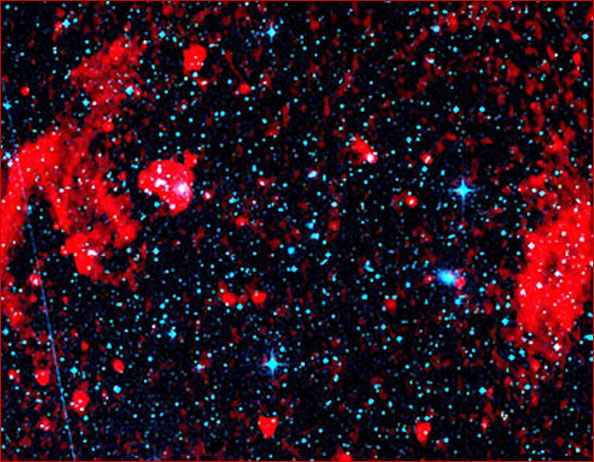
home •
about •
essential guide •
picture of the day •
thunderblogs •
news •
multimedia •
predictions •
products •
get involved •
contact
picture of the day archive subject index
Caption: Giant arcs of radio emission detected by the Very Large Array of radio telescopes in New
Mexico enclose a vast cluster of galaxies, called Abell 3376.
Nov 13, 2006
Another Electrical “Shock” for Astronomers
Unexpected, highly energetic radio emissions from galaxy cluster Abell 3376 have sparked a curious “debate” among astronomers.
The galaxy cluster Abell 3376 lies about 600 million light years away from the earth. As seen in the picture above, two ends of the cluster reveal giant arcs of high-energy radio emission, each about three million light-years across. (For reference: just one light year is almost 6 trillion miles.) Something is occurring on a macrocosmic scale that challenges traditional concepts of galaxies moving in splendid isolation, and connected only by the trivial gravitational force. Here, thousands of galaxies are indisputably linked to coherent, high-energy events.
For plasma cosmologists and Electric Universe proponents, the electric force is the only meaningful and testable explanation for such a vast radio source in space. It is therefore with dismay that the electrical theorists consider the conventional discussion sparked by this latest “surprise.”
As one plasma scientist has put it to us, conventional theory typically envisions high-energy events on a galactic or intergalactic scale in terms of celestial objects smashing together. So two sides will often debate ways to accomplish this.
As summarized on NewScientist.com, one interpretation suggests: “…roughly a billion years ago, two clusters crashed into one another to form Abell 3376. The collision could have sparked a shockwave that traveled out through the cluster gas, whose remnants we are now seeing.”
But according to the New Scientist article, “…there is a more intriguing possibility. Primordial gas, untouched since the big bang, should be constantly pouring into all galaxy clusters…and the two shockwaves could mark where this cool ancient gas smacks into the super-hot gas of the cluster.”
Interpretations of this sort underscore the gap that has developed between standard cosmology and plasma cosmology. In plasma cosmology, it is the electric force that accelerates charged particles at energies up to 1020 electron volts. This interpretation rests on practical laboratory experiments with particle acceleration, and involves no ad hoc speculations. To ask some imagined mechanical “shock” to achieve such acceleration is to take astronomy into untestable conjecture.
As if to make the plasma cosmologists’ point for them, the article states that these “shockwaves” “could also give us a clue as to why the universe is threaded with magnetic fields.” But nowhere in the article do we find any reference to the electric currents that create and sustain magnetic fields. One of the pointers to magnetic fields is filamentation of space plasma. In the electrically neutral environment originally envisioned by big bang cosmologists, any concentration of gases into a filament would quickly dissipate into equilibrium with surrounding gases. But in an Electric Universe, filamentation should be commonplace because of a basic property of plasma that occurs when it carries an electric current. And since every electric current creates a magnetic field, no other explanation for the pervasive magnetic fields in space is necessary: the induced magnetic fields constrict the plasma into narrow filaments often spanning vast cosmic distances. And these filaments become the efficient pathways of the currents. Universally present magnetic fields and associated filamentation mean an Electric Universe.
Consider in contrast the logic expressed in the article as the author addresses the enigma of filamentation: “Computer simulations of the cosmos show that gravity tends to pull the gas into stringy structures called filaments…Abell 3376 could be threaded on one such filament…”
The best expression for computer simulations designed to retrofit a theory to surprising observations is “garbage in, garbage out.” When did any gravitational model simulate filamentation prior to the astonishing discovery of a filamentary universe? To assume that the virtually zero influence of gravity in intergalactic space is producing energy at radio wave and x-ray levels gives new meaning to the phrase “doing things the hard way.”
Since Professor Don Scott’s book The Electric Sky will be available later this month, it is fitting to present here his analysis of the underlying issue posed by x-ray and radio emissions in space:
1. Radio telescopes see radio waves throughout the cosmos.
2. Radio waves need BOTH magnetic and electric fields in order to exist.
3. Magnetic fields need electric currents in order to exist.
4. We can conclude that electric currents and electric fields exist in deep space.
5. Cosmic rays are accelerated ions.
6. What is the easiest way to accelerate an ion?
7. Answer: By letting it fall through a voltage drop (an electric field) or pump it magnetically.
8. Strong electric fields exist in DLs (double layers) in plasma and magnetic pumping can occur in moving (varying) magnetic fields.
9. Grasping at “bow shocks” as a reason for ion acceleration is an evasive refusal to consider anything electrical.
___________________________________________________________________________Please visit our Forum
The Electric Sky and The Electric Universe available now!

|
|

|
EXECUTIVE EDITORS:
David Talbott, Wallace Thornhill
MANAGING EDITORS:
Steve Smith, Mel Acheson
CONTRIBUTING EDITORS: Dwardu Cardona, Ev Cochrane,
C.J. Ransom, Don Scott, Rens van der Sluijs, Ian Tresman
WEBMASTER: Brian Talbott
Copyright 2006: thunderbolts.info
![]()
home •
thunderblogs •
forum •
picture of the day •
resources •
team •
updates •
contact us

